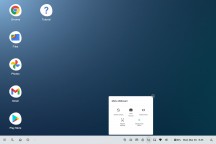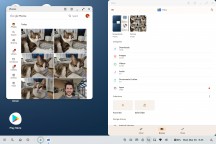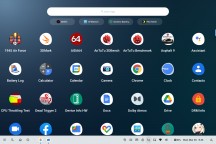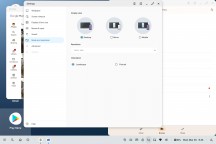Motorola Edge 30 Pro review

Pixel-like Android 12 with some additional Moto mods
The Edge 30 Pro runs Android 12 from the get-go. The look and feel are the closest we've seen to the Android 12 you'd get on a Google Pixel phone and we can imagine that in itself being a driving factor in choosing a Moto for folks in regions where the Pixels aren't officially sold. Or that's just our delusions from the reviewers' bubble we live in. Anyway, let's have a look.

Immediately noticeable is the new Quick Settings interface and notification shade, one of Android 12's more striking visual changes. That means the big bubbly buttons, of which you only get 4 on the first pull, up to 8 on the second, and the full-screen notification shade.
On to widgets, which saw an overhaul with Android 12. The widget picker offers responsive previews for differently sized widgets. The new API supports dynamic coloring by tying into the Material You theming engine, allowing the widgets to adapt to the wallpaper.






Quick settings • Notification shade • Widgets
Another Android 12 staple, the Material You autotheming feature is here too, though it's masked behind a slightly customized Moto-specific theming engine. You can still get wallpaper-based accent colors and those will apply to Google apps and the settings menu as well.
Privacy is an especially big deal on Android 12, and the Edge 30 Pro comes with the latest Google's come up with in the field. That includes the new Privacy dashboard which offers a unified view into what permission is being used by what app when. There are also the camera and microphone indicators in the top right corner of the screen for an immediate clue that you're being watched/listened to, but also the quick toggles to limit access to those altogether. The option to determine whether an app gets your precise coordinates or an approximate location is also here.
Other less prominent bits from the new OS version made it to the Edge 30 Pro as well. Things like the Extra dim display mode and the window magnifier, the new power menu, the improved PiP behavior.
There's a scrolling screenshot implementation, but that's not Google's own, and a custom one instead. Then again, custom scrolling screenshots have been around for ages, it was Google that only now came to its senses.
A few other things appear to not have made it on the Edge 30 Pro's Android 12 build. Off the top of our heads those include the face detection-based auto rotate behavior, copying stuff from app to app from the task switcher, and the system-wide on-device search from the app drawer.
However, there are features and functionality that the Edge 30 Pro offers, which Google doesn't - the lot of them conveniently grouped together in the hub that it the Moto app. These are mostly long-standing Moto features we've seen time and time again.
The first category is personalization - that's where the OS-native autotheming found a foster home. There is also a wide selection of Moto wallpapers in addition to Google's own, plus the option to leverage AI to create your own from the photos in your gallery.
Then come the gestures. By now, you all must have seen the karate chop motion that turns on and off the flashlight and the twisting motion that launches the camera app. Both work even when the device is locked.
The lift-to-unlock gesture works well with the face unlock as it unlocks the device as soon as you pick it up and look at the screen.
A swipe-to-split function is available, too - it triggers the split-screen multitasking. There is also Power touch - when you double-tap the power button, a shortcut menu appears. You can arrange the icons in it to include apps, tools and even contacts for quick access.
The display-related features are Peek Display and Attentive Display. The former works as a second-best alternative to the Always-on display feature, which is actually missing, but with some added functionality to make up for it.
The screen lights up when it detects motion that's close to the phone or when you pick it up. Once you've received some kind of notification, you can tap on it and see the message itself and even interact with it from the lock screen.
Attentive Display disables the screen timeout as long as there's a face looking at the screen. Pretty useful when reading long articles, though you do probably scroll often enough for the screen not to lock anyway.
Then there's the Play section. In here you'll find the Gametime utility which offers the usual functionality of such tools like call and notification blocking and screen recording. Additionally, there are optional shortcuts for media playback when the screen is locked using the volume keys, as well as a Dolby Atmos sound enhancement utility.
Introduced in 2021, Motorola's 'ready for' platform enables a multitude of use cases that put the phone in the center of a big-screen experience. By connecting a TV or a monitor, you can get a Windows-desktop-like environment, play a game on your phone, display it on the external screen, or even have a video chat on a larger display.
The connection can be done with a cable - either with the 'ready for' cable (or another USB-C MHL Alt solution) or with a USB-C-to-C cable with a compatible monitor. Alternatively, you can connect wirelessly to a Miracast-capable display.
If you don't have a mouse and/or keyboard handy, the phone's screen can be used as a trackpad and/or keyboard.
You can also use 'ready for' on a Windows-based PC - it runs within a window on your desktop. This is helpful for when you want to run an Android app from your computer or to multi-task between devices on just one screen.
Another use case of 'ready for' on a Windows PC is for video calls, where you can use the phone's camera to capture yourself and an external display to see the other participants.
The final Ready For use case is for gaming on a bigger screen - be it TV or laptop/monitor. You connect an external controller and run the game on the phone, with the obvious benefit being the larger display for gameplay.
Performance and benchmarks
The Edge 30 Pro uses the Snapdragon 8 Gen 1 for its number crunching, so it's got a proper flagship chipset inside, as opposed to the Edge 20 Pro and its SD870. We've seen several handsets with Qualcomm's top-tier SoC, so we have plenty of points for comparison.
The Moto exists in no less than 5 different memory configurations ranging from a base 8GB/128GB version to a properly impressive 12GB/512GB, though your particular region will likely only get one or two options. Our review unit is the 12GB/256GB spec.

In GeekBench, the Edge 30 Pro posted excellent results for CPU performance - as expected from its latest-gen chipset. Being one of the lowest points of entry into Snapdragon 8 Gen 1 goodness, particularly in some regions, it's good to know that the Moto does actually deliver.
GeekBench 5 (multi-core)
Higher is better
-
iQOO 9 Pro
3708 -
Xiaomi 12 Pro
3682 -
Asus Zenfone 8 Flip
3673 -
Motorola Edge 30 Pro
3658 -
Xiaomi 12
3652 -
Samsung Galaxy S22+
3528 -
Realme GT2 Pro
3501 -
Samsung Galaxy S21+ 5G
3476 -
vivo X70 Pro+
3469 -
OnePlus 10 Pro
3447 -
Oppo Find X5 Pro
3433 -
Motorola Moto G200 5G
3319 -
Huawei P50 Pro
3145 -
Motorola Edge 20 Pro
3140 -
Samsung Galaxy S21 FE 5G
3049 -
vivo X70 Pro
2956
GeekBench 5 (single-core)
Higher is better
-
Realme GT2 Pro
1238 -
iQOO 9 Pro
1231 -
Motorola Edge 30 Pro
1196 -
Xiaomi 12
1187 -
Xiaomi 12 Pro
1169 -
Samsung Galaxy S22+
1165 -
Asus Zenfone 8 Flip
1126 -
vivo X70 Pro+
1106 -
Huawei P50 Pro
1105 -
Samsung Galaxy S21 FE 5G
1096 -
Motorola Moto G200 5G
1096 -
Samsung Galaxy S21+ 5G
1091 -
Oppo Find X5 Pro
1002 -
OnePlus 10 Pro
975 -
Motorola Edge 20 Pro
972 -
vivo X70 Pro
875
The Moto takes a step back in Antutu, and while it comfortably outscores the Galaxy S22+ in Exynos trim and all the models with last-year's chipset, other SD8G1 handsets do manage some extra points.
AnTuTu 9
Higher is better
-
Oppo Find X5 Pro
1012896 -
iQOO 9 Pro
997948 -
Xiaomi 12 Pro
985226 -
Xiaomi 12
985115 -
Realme GT2 Pro
966251 -
Motorola Edge 30 Pro
941895 -
Samsung Galaxy S22+
886916 -
OnePlus 10 Pro
886248 -
vivo X70 Pro+
837833 -
Motorola Moto G200 5G
811124 -
Asus Zenfone 8 Flip
797484 -
Huawei P50 Pro
786215 -
Samsung Galaxy S21 FE 5G
719696 -
Motorola Edge 20 Pro
711090 -
vivo X70 Pro
694499
The Moto comes into its own in onscreen graphics benchmarks, where the combination of a FullHD screen and a super-powerful GPU makes for some chart-topping fps results.
GFX Aztek ES 3.1 High (onscreen)
Higher is better
-
Motorola Edge 30 Pro
59 -
Xiaomi 12
59 -
Samsung Galaxy S22+
50 -
Samsung Galaxy S21+ 5G
43 -
Asus Zenfone 8 Flip
41 -
Samsung Galaxy S21 FE 5G
38 -
OnePlus 10 Pro
37 -
Realme GT2 Pro
36 -
iQOO 9 Pro
36 -
Xiaomi 12 Pro
36 -
Oppo Find X5 Pro
35 -
Motorola Edge 20 Pro
31 -
vivo X70 Pro
31 -
Huawei P50 Pro
27 -
vivo X70 Pro+
25
GFX Aztek Vulkan High (onscreen)
Higher is better
-
Motorola Edge 30 Pro
60 -
Xiaomi 12
59 -
Samsung Galaxy S22+
51 -
Asus Zenfone 8 Flip
45 -
OnePlus 10 Pro
41 -
Realme GT2 Pro
39 -
Samsung Galaxy S21 FE 5G
38 -
Samsung Galaxy S21+ 5G
37 -
iQOO 9 Pro
37 -
Xiaomi 12 Pro
37 -
Oppo Find X5 Pro
36 -
Motorola Edge 20 Pro
35 -
vivo X70 Pro
29 -
Huawei P50 Pro
26 -
vivo X70 Pro+
26
GFX Car Chase ES 3.1 (onscreen)
Higher is better
-
Motorola Edge 30 Pro
78 -
Xiaomi 12
75 -
Samsung Galaxy S22+
68 -
Asus Zenfone 8 Flip
62 -
Motorola Moto G200 5G
60 -
Samsung Galaxy S21 FE 5G
56 -
Samsung Galaxy S21+ 5G
54 -
Motorola Edge 20 Pro
49 -
OnePlus 10 Pro
48 -
Realme GT2 Pro
48 -
iQOO 9 Pro
46 -
Xiaomi 12 Pro
46 -
Oppo Find X5 Pro
44 -
Huawei P50 Pro
44 -
vivo X70 Pro
40 -
vivo X70 Pro+
33
GFX Manhattan ES 3.1 (onscreen)
Higher is better
-
Xiaomi 12
117 -
Motorola Edge 30 Pro
111 -
Asus Zenfone 8 Flip
104 -
Samsung Galaxy S21+ 5G
100 -
Samsung Galaxy S21 FE 5G
98 -
Motorola Moto G200 5G
97 -
Samsung Galaxy S22+
94 -
OnePlus 10 Pro
89 -
Xiaomi 12 Pro
86 -
iQOO 9 Pro
84 -
Motorola Edge 20 Pro
83 -
vivo X70 Pro
77 -
Huawei P50 Pro
72 -
Realme GT2 Pro
60 -
vivo X70 Pro+
58
In the offscreen runs, the Moto is a smidge behind the rest of the SD8G1 bunch, but it's hardly a reason to be concerned. It's still significantly ahead of 2021 hardware, as it should be, and it also outperforms the E2200 Galaxy S22+.
GFX Aztek ES 3.1 High (offscreen 1440p)
Higher is better
-
OnePlus 10 Pro
43 -
Realme GT2 Pro
42 -
Xiaomi 12 Pro
41 -
Xiaomi 12
41 -
iQOO 9 Pro
40 -
Oppo Find X5 Pro
40 -
Motorola Edge 30 Pro
39 -
Samsung Galaxy S22+
31 -
Samsung Galaxy S21+ 5G
28 -
Asus Zenfone 8 Flip
28 -
vivo X70 Pro+
27 -
Samsung Galaxy S21 FE 5G
24 -
Motorola Edge 20 Pro
22 -
Huawei P50 Pro
22 -
vivo X70 Pro
21
GFX Aztek Vulkan High (offscreen 1440p)
Higher is better
-
OnePlus 10 Pro
48 -
Realme GT2 Pro
46 -
Motorola Edge 30 Pro
45 -
Xiaomi 12 Pro
45 -
Xiaomi 12
45 -
iQOO 9 Pro
44 -
Oppo Find X5 Pro
44 -
Samsung Galaxy S22+
34 -
Asus Zenfone 8 Flip
31 -
Huawei P50 Pro
30 -
vivo X70 Pro+
29 -
Samsung Galaxy S21+ 5G
26 -
Samsung Galaxy S21 FE 5G
25 -
Motorola Edge 20 Pro
24 -
vivo X70 Pro
20
GFX Car Chase ES 3.1 (offscreen 1080p)
Higher is better
-
OnePlus 10 Pro
97 -
Xiaomi 12 Pro
96 -
Motorola Edge 30 Pro
95 -
Realme GT2 Pro
95 -
iQOO 9 Pro
95 -
Oppo Find X5 Pro
94 -
Xiaomi 12
84 -
Samsung Galaxy S22+
76 -
Asus Zenfone 8 Flip
69 -
Samsung Galaxy S21+ 5G
66 -
vivo X70 Pro+
66 -
Huawei P50 Pro
64 -
Motorola Moto G200 5G
62 -
Motorola Edge 20 Pro
57 -
Samsung Galaxy S21 FE 5G
57 -
vivo X70 Pro
45
GFX Manhattan ES 3.1 (offscreen 1080p)
Higher is better
-
OnePlus 10 Pro
175 -
Xiaomi 12 Pro
168 -
Realme GT2 Pro
165 -
Xiaomi 12
164 -
Oppo Find X5 Pro
162 -
Motorola Edge 30 Pro
160 -
iQOO 9 Pro
160 -
Asus Zenfone 8 Flip
118 -
Samsung Galaxy S21+ 5G
111 -
Samsung Galaxy S22+
105 -
vivo X70 Pro+
105 -
Samsung Galaxy S21 FE 5G
103 -
Huawei P50 Pro
99 -
Motorola Edge 20 Pro
92 -
Motorola Moto G200 5G
85 -
vivo X70 Pro
85
3DMark Wild Life Vulkan 1.1 (offscreen 1440p)
Higher is better
-
Oppo Find X5 Pro
9758 -
iQOO 9 Pro
9673 -
Xiaomi 12 Pro
9664 -
OnePlus 10 Pro
9610 -
Xiaomi 12
9535 -
Realme GT2 Pro
9487 -
Motorola Edge 30 Pro
9406 -
Samsung Galaxy S22+
7405 -
Samsung Galaxy S21+ 5G
5757 -
Asus Zenfone 8 Flip
5677 -
Huawei P50 Pro
5651 -
Motorola Moto G200 5G
5617 -
Samsung Galaxy S21 FE 5G
5432 -
vivo X70 Pro+
5332 -
Motorola Edge 20 Pro
4206 -
vivo X70 Pro
4148
When it comes to stability under sustained load, we observed a peculiar duality in the Edge 30 Pro's results. It returned 62% in the 3DMark Wildlife stress test, whici is essentially the ballpark flagship phones tend to end up in. It was then more than a little surprising that the Edge 30 Pro posted a solid 84% result in the CPU throttling test, with essentially no deep dips throughout the 1-hour test.


CPU throttling test • 3DMark Wildlife stress test
That's a most welcome finding. We're theorizing that CPU performance stability is probably something Motorola spent deliberate efforts beyond your average smartphone maker, in light of the phone's potential use as a 'ready for' PC replacement.
Reader comments
- Poppa
- 24 Jul 2024
- 7sx
If you want a camera phone. Get a pixel. I have owned the 30 pro for a year and it is absolutely capable of running an otg USB HDMI/ ethernet hub and acting like a chrome book on roids. Processor actually designed by snap dragon and AMD. JB hif...
- Anonymous
- 19 Mar 2024
- tZ4
The Edge 30 Pro is promised 2 OS and 3 years security updates. While that is bad for a flagship, it gets worse for lower Motorola models. Most Moto G models only getting 1 OS and 2 years security while E models usually dont get any OS update. M...
- Anonymous
- 20 Oct 2023
- 0fC
Totally agree with the cons why on earth not have ip68 rating or use the same one as motorola defy 2021 and keep the telephoto camera that used on the edge 20 and edge 20 pro instead of a hideous 2mp depth camera come on motorola what were you thinki...
















































